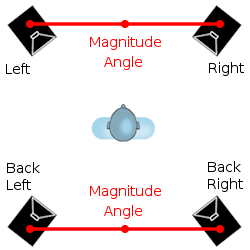Quadrophonic System
http://people.xiph.org/~xiphmont/surround/demo.html
Accessed: 16/04/13
In order to begin talking about the Quadrophonic Era we must first know the difference between Matrix Encoded multichannel audio and Discrete multichannel audio:
Matrix Encoded:
Matrix encoded multichannel audio is where the surround and centre channels are created by using combinations of the original left and right stereo channels, otherwise known as Upmixing. Seen as the centre and surround channels will include information that is also in the front left and right channels, matrix encoded multichannel audio cannot isolate sounds to the surround channels.
Discrete:
Discrete multichannel audio is where the centre and surround channels are encoded on separate streams rather than being matrixed from a stereo signal. Discrete audio allows sounds to be isolated completely to the surround and centre channels creating better directionality and localisation.
The Quad Era saw many different engineers design different matrixes that would help reproduce 4 channels of audio from a Vinyl disc, such as Peter Scheiber's 4-2-4 matrix that allowed 4 channels to be compressed into 2 and then restored to 4 again using wide band phase-shift networks in the encoding and decoding process. One of Scheiber's demonstrations of his matrix to CBS executives caught the interest of Benjamin B. Bauer, who then went on to design the SQ (stereo-quad) matrix with the help of the CBS Laboratories. Bauer claimed that his matrix had better spatial attributes and compatibility with stereo and monophonic playback and it was this invention that earned him his nick name of the "Quad Father", however it was not long before many other matrixes were invented such as the, QMX matrix from Duane Cooper, QS matrix from the Sansui Corporation and Ambisonics from Michaul Gerzon in the UK.
Now that there were so many different quadrophonic matrixes available, it wasn't the question of which matrixes would become the standard, but whether either matrix or discrete surround audio would become the standard for multichannel audio. The invention of the CD-4 record from the JVC Corporation and RCA Records saw the end of this debate as it allowed the reproduction of discrete audio.
Although the Quadrophonic Era saw to many new inventions such as multichannel audio matrixes, it had failed to become a great success. There are many different speculations as to why the quad system had failed such as, there were too many competing formats for the music dealers, and they would have to provide all of their products in three different formats, stereo record, cassette tape and quad record, which didn't see any extra profit to the dealers and record companies. Other reasons for the Quad Systems failure were that the market was not warming to the idea of having two extra loudspeakers in there listening space and also record producers were not able to exploit the medium as they believe it:
"locked them into rigid four-cornor reproduction"
Emil Torick
Highlights in the History of Multichannel Surround
Audio Engineering Society Journal, Vol.46, No. 1/2
January/February 1998
Emil Torick also describes how the Quad Era failed in and interview with the AES:
http://www.youtube.com/watch?v=rJhC7VchDuo
accessed: 17/04/13
Having discussed the reasons for the Quad System's failure in the music industry, it is interesting to relate this to the 5.1 Surround Sound System, which is now a standardised format. The 5.1 System is hugely popular and the standard for film and becoming more and more popular in the gaming industry with the invention Surround Sound headphones. However it's uses in the Music Industry has been more elusive, is this because of the same reason as the Quad Era? Do record companies not produce 5.1 music material because it would not increase profits? Is Stereo then the standard format for the music industry?
References:
Emil Torick
Highlights in the History of Multichannel Surround
Audio Engineering Society Journal, Vol.46, No. 1/2
January/February 1998
http://www.youtube.com/watch?v=rJhC7VchDuo
accessed: 17/04/13
Holman Tomlinson, 2008,
Surround Sound Up and Running,
Second Edition

No comments:
Post a Comment